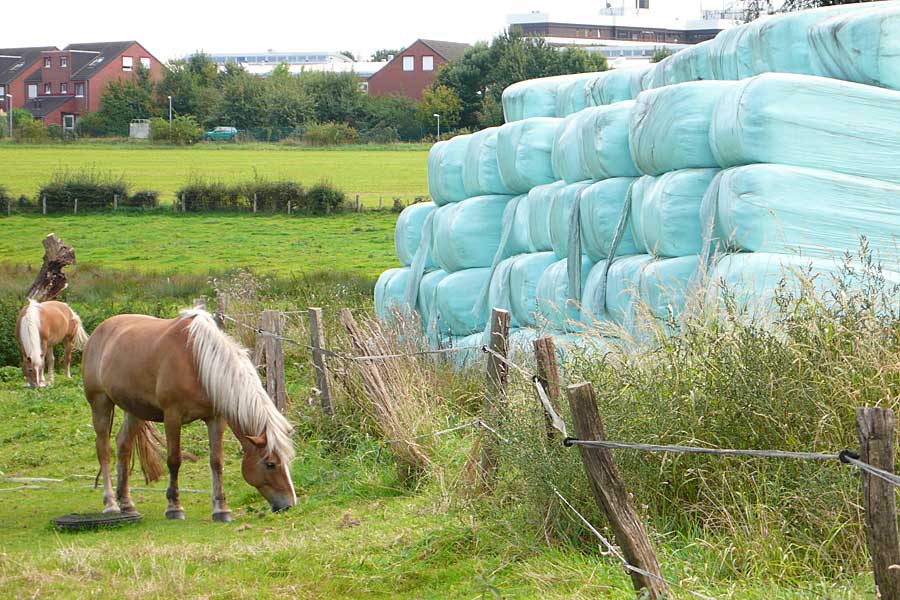Silage For Horses
Silage for horses
Also in the feeding of horses silage is an appreciated component of the ration. Silage has unique benefits, so that not only a few horse owners prefer feeding silage over feeding hay.

Just like making hay, making silage is a way to make forage storable. Crucial for hay is the drying process – if the DM content is lower than 80%, there are severe issues with moulds and yeasts to be expected. The factor „weather“ is one of the critical items, which determine the quality of hay. If farmers cannot dry their grass in time, they often switch from making hay to making silage in order to avoid a total loss of valuable forage. The process of silage-making is based upon the conversion of plant sugar into lactic acid – long wilting periods with a high risk of nutrient losses are not necessary.
But how does a good silage for horses look like? Horses are normaly kept for riding and they don’t have to produce milk or deliver meat. Therefore their fodder should not contain too high amounts of energy but enough fibre. In any case, the silage should have a high fermentation quality in combination with an excellent feed hygiene. The amount of yeasts, moulds and/or other undesired microbes should be as low as possible not to affect animals health. Another big advantage of silage in comparison to hay is the absence of dust. Especially for some horses (and horsekeepers too) with respiratory problems feeding of silage can have a very positive effect on health.
For horses a high-quality silage is as palatable as good hay. However the feed value depends on the botanical composition of the sward which can be steered by competent grassland management.
Swards which are intended to provide silage fodder for horses are mostly cut later than forage for cow silage. That means the content of fibre is significantly higher whereas the amount of energy is lower. Many farmers let the grass wilt up to a DM of 45-55%, here we speak of haylage. At such high levels of DM problems with warming up (aerobic deterioration) of the haylage frequently occur. If haylage is pressed in bales it is also called baleage or balage.
Poorly compacted and too dry pressed forage does not ferment sufficiently. After opening, a bale will quickly flowed through by fresh air. Atmospheric oxygen will initiate growth of mold, yeasts and other unwanted microbes. That results into rapid heating and spoilage of the silage.
The sward should therefore no be cut and ensiled too late in order to archive aerobic stability. Properly maintained harvesting machinery is a must.
Botulism and laminitis caused by feeding of silage?
Laminitis is a disease dreaded by horse owners .This disease, which affects ungulate, can have different causes. One of them is related to feeding, especially too much protein was long time considered to be the main reason for this illness. Newer studies have moved fructanes into the focus of interest now. These plant sugars are supposed to trigger the painful hoof disease.
Fructanes are produced in grasses during photosynthesis and serve as energy store. Horses can’t digest these carbohydrates properly, so that the fructanes reach the large intestine and bring the bacterial flora into disorder. Many bacteria die and their toxic metabolites cause inflammation of the lamina of the hoof, which can lead to the detachment of the hoof capsule.
Therefore, the content of fructanes in horse feed (fresh grass, hay or silage) should be low. In silage, plant sugars are converted by lactic acid bacteria into preserving lactic acid. Does the fermentation process works properly, only a fraction of the original amount of fructanes can be detected in the silage. According to WEISSBACH (2006), fructane contents of less than 5% in the DM of horsefeed are to be classified as harmless. The well-established principles of good practice are confirmed here: especially an early cut and moderate wilting have a positive influence on the fermentation process. If the fermentation is incomplete, residual sugars remain in the silage. Amongst them also fructanes which endanger the health of the horses. Anyway, the forage for feeding horses should contain low-fructose grass species to obviate problems with laminitis.
In connection with the feeding of silage, some horse owners also fear problems with botulism. In fact, there have been cases of disease after horses (or cows) have been fed with silage. What happended? Soil-borne pathogenes / bacteria infected unintentionally ensilaged small animals (like mice, rabbits or birds) and multiplied on their carcasses in the silage. Horses or cattle took up the feed and became ill or even died. But this can also happen when making hay.
It would be wrong, to assign the occurrence of botulism only to the process of „silage-making“. Careful adjustment and maintenance of the harvesting machinery, avoiding the contamination of forage with soil during the ensilaging and chasing off animals during mowing and harvesting will reduce the risk of botulism dramatically.
A good silage for horse feeding has the following characteristics:
- a rather moderate content of energy with low content of fructanes
- a fresh green / greenish-brown colour
- a pleasant smell, not butyric, musty or burnt / roasted
- a sufficient content of fibre to stimulate the digestive system
- a low content of soil-pollution
- long aerobic stability even after opening the bales for feeding
To archive these goals here are some tips:
- swards should not contain too energy-rich varieties of grass
- don’t harvest too late to avoid problems with compaction and warming up
- don’t cut the sward too deep to prevent contamination with soil
- avoid excessive wilting
- use silage-additives when necessary to prevent from aerobic deterioration or butyric fermentation
- handle baled silage with care and avoid injuries to the stretch film
- feed bales after opening as soon as possible